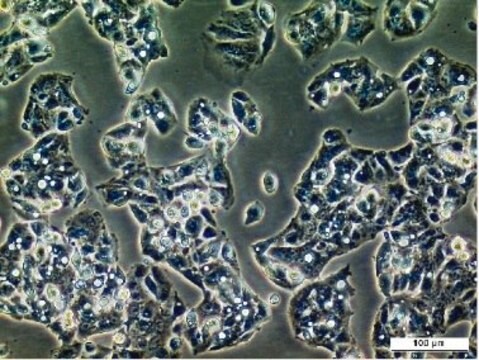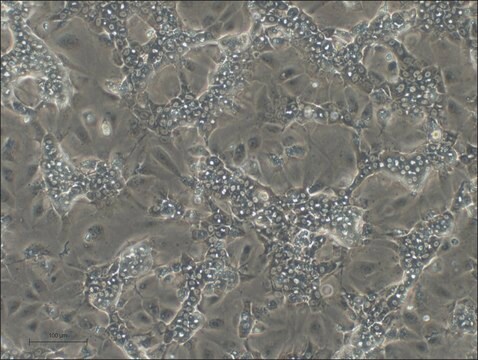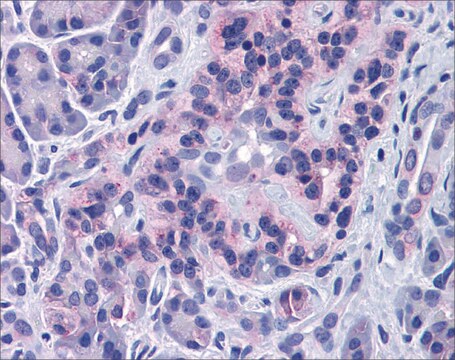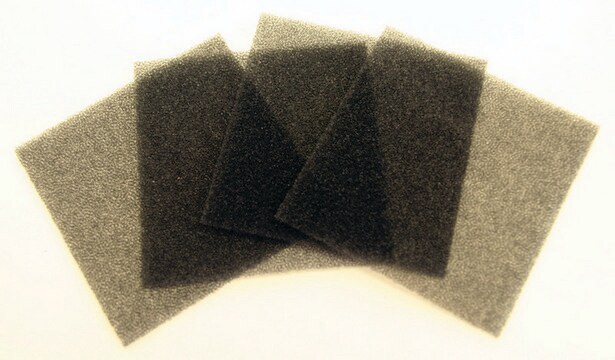SCC613
LX-2 Cas9 Human Hepatic Stellate Cell Line
Synonim(y):
HSC Cas9;Perisinusoidal cells Cas9;Ito cells Cas9;Hepatic pericytes Cas9;Hepatic stellate cells Cas9
Zaloguj sięWyświetlanie cen organizacyjnych i kontraktowych
About This Item
Kod UNSPSC:
41106514
NACRES:
NA.81
Polecane produkty
pochodzenie biologiczne
human
Poziom jakości
opakowanie
vial of ≥1X10⁶ cells/vial vial
producent / nazwa handlowa
Millipore
tryb wzrostu
N/A
metody
cell culture | mammalian: suitable
Warunki transportu
liquid nitrogen
temp. przechowywania
−196°C
Zastosowanie
- Each vial contains >1X106 viable cells.
- Cells are tested negative for infectious diseases by a Human Essential CLEAR Panel by Charles River Animal Diagnostic Services.
- Cells are verified to be of human origin and negative for interspecies contamination from mouse, rat, Chinese hamster, Golden Syrian hamster, and nonhuman primate (NHP) as assessed by a Contamination Clear panel by Charles River Animal Diagnostic Services
- Cells are negative for mycoplasma contamination.
Hepatic stellate cells are a cell type responsible for liver fibrosis following their activation to fibrogenic myofibroblast-like cells in diseases such as chronic alcoholism, hepatitis B and C, fatty liver disease, obesity and diabetes. Given the importance of stellate cells in disease etiology, genetically malleable cellular models are critical for understanding the contribution of these cells to liver pathologies and necessary for development of new therapeutics.
The immortalized LX-2 line was established by Xu et al to overcome issues of culture variability and to provide a stable and unlimited source of human hepatic stellate cells that are homogeneous. These cell lines have been extensively characterized and retain key features of cytokine signaling, neuronal gene expression, retinoid metabolism, and fibrogenesis, making them highly suitable for culture based studies of human hepatic fibrosis.
Source
LX-2 Cas9 human hepatic stellate cells were derived from LX-2 cells transformed with a Cas9 cassette.
LX-2 was generated by immortalization of primary human hepatic stellate cells with the SV40 large T antigen followed by selective culture of early passage cells in low serum media conditions.
References
1.Gut 2005, 54(1): 142-151.
2.PloS One 2013, 8(10): e75692.
The immortalized LX-2 line was established by Xu et al to overcome issues of culture variability and to provide a stable and unlimited source of human hepatic stellate cells that are homogeneous. These cell lines have been extensively characterized and retain key features of cytokine signaling, neuronal gene expression, retinoid metabolism, and fibrogenesis, making them highly suitable for culture based studies of human hepatic fibrosis.
Source
LX-2 Cas9 human hepatic stellate cells were derived from LX-2 cells transformed with a Cas9 cassette.
LX-2 was generated by immortalization of primary human hepatic stellate cells with the SV40 large T antigen followed by selective culture of early passage cells in low serum media conditions.
References
1.Gut 2005, 54(1): 142-151.
2.PloS One 2013, 8(10): e75692.
Cechy i korzyści
The LX-2 Cas9 human hepatic stellate cell line has been extensively characterized and retains key features of hepatic stellate cytokine signaling, neuronal gene expression, retinoid metabolism, and fibrogenesis , making it a highly suitable model of human hepatic fibrosis.
Przechowywanie i stabilność
LX-2 Cas9 cells should be stored in liquid nitrogen. The cells can be cultured for at least 10 passages without significantly affecting cell marker expression and functionality. LX-2 cells have been successfully expanded beyond passage 50 in culture.
Inne uwagi
This product is intended for sale and sold solely to academic institutions for internal academic research use per the terms of the “Academic Use Agreement” as detailed in the product documentation. For information regarding any other use, please contact licensing@emdmillipore.com.
Oświadczenie o zrzeczeniu się odpowiedzialności
RESEARCH USE ONLY. This product is regulated in France when intended to be used for scientific purposes, including for import and export activities (Article L 1211-1 paragraph 2 of the Public Health Code). The purchaser (i.e. enduser) is required to obtain an import authorization from the France Ministry of Research referred in the Article L1245-5-1 II. of Public Health Code. By ordering this product, you are confirming that you have obtained the proper import authorization.
Unless otherwise stated in our catalog or other company documentation accompanying the product(s), our products are intended for research use only and are not to be used for any other purpose, which includes but is not limited to, unauthorized commercial uses, in vitro diagnostic uses, ex vivo or in vivo therapeutic uses or any type of consumption or application to humans or animals.
This page may contain text that has been machine translated.
produkt powiązany
Numer produktu
Opis
Cennik
Kod klasy składowania
10 - Combustible liquids
Klasa zagrożenia wodnego (WGK)
WGK 2
Temperatura zapłonu (°F)
Not applicable
Temperatura zapłonu (°C)
Not applicable
Certyfikaty analizy (CoA)
Poszukaj Certyfikaty analizy (CoA), wpisując numer partii/serii produktów. Numery serii i partii można znaleźć na etykiecie produktu po słowach „seria” lub „partia”.
Masz już ten produkt?
Dokumenty związane z niedawno zakupionymi produktami zostały zamieszczone w Bibliotece dokumentów.
Nasz zespół naukowców ma doświadczenie we wszystkich obszarach badań, w tym w naukach przyrodniczych, materiałoznawstwie, syntezie chemicznej, chromatografii, analityce i wielu innych dziedzinach.
Skontaktuj się z zespołem ds. pomocy technicznej







